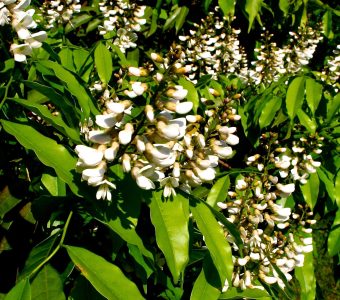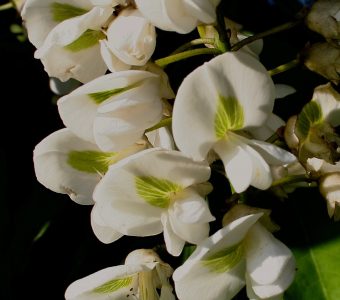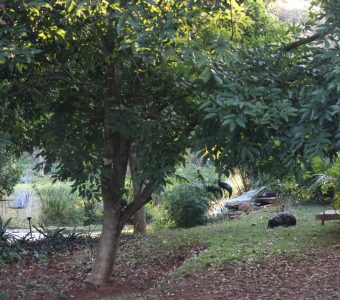


Botanical Name: Craibia brevicaudatum
Common Name: Mountain Craibia, Mupande, Mpange
Plant Family: Fabaceae (Legume Family) Papilionoideae
Growth Form, Habitat and Distribution: A medium semi-evergreen spreading tree, the trunk often buttressed and fluted at the base. The branches give a dense crown with drooping edges. Confined to the wetter northern and north-eastern parts of Zambia. Typically occurs in riverine, relict evergreen thicket and montane woodland and sometimes in Itigi thicket. Craibia affinis is similar, has more lanceolate leaflets and a wider northern distribution. C. grandiflora has longer and wider leaflets..
Size: Height up to 18m, spread up to 12m.
Bark: Pale grey and smooth becoming scaly with age in square flakes.
Leaves: Alternate, compound, imparipinnate, with 5 to 7 shiny dark green, leathery leaflets (6 to 11cm), arranged alternately, apex tapering and margin wavy elliptic to oblong-lanceolate. Petiole grooved.
Flowers: Showy displays of white flowers with a pink tinge, sweet pea-like in short, dense sprays up to 15cm at branch-ends, October to January.
Fruit: A flat, green to creamy-grey, asymmetrically tapering pod, 8 to 10cm, dehiscent and becoming dark brown before exploding. 1 or 2 large, glossy reddish seeds shed up to 15m from the tree, May and June.
Uses: Difficult to grow but makes a beautiful specimen tree in a garden.
Other Species in Zambia: 2 other species: C. affinis has lanceolate leaves and C. grandiflora, also confined to northern Zambia.
